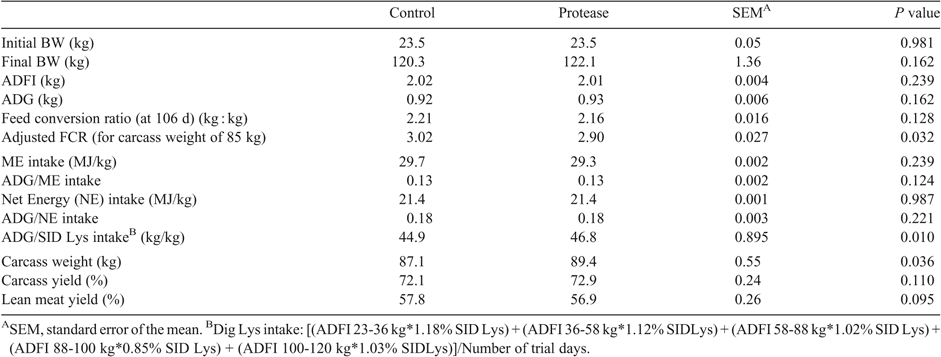Assessment of the effects of a serine protease on commercial grower-finisher pig performance in Brazil
R. S. Toledo A B , A. G. Rocha A and C. Schaefer AA Cooperativa Central Aurora, Chapeco, Santa Catarina, Brazil.
B Corresponding author. Email: rodrigo-toledo@auroraalimentos.com.br
Animal Production Science 55(12) 1562-1562 https://doi.org/10.1071/ANv55n12Ab073
Published: 11 November 2015
The swine industry in Brazil is constantly looking for reductions in feed costs and use of highly digestible ingredients to improve performance and reduce nutrient excretion. Among alternatives, the use of exogenous enzymes, such as protease, has been intensified in order to improve the digestibility of protein and amino acids (Guggenbuhl et al. 2012), reduce the inclusion of protein ingredients and improve performance (Rooke et al. 1998). The aim of this study was to evaluate if the inclusion of a serine protease in pigs’ diet could reduce the inclusion of protein ingredients without compromising performance.
Ninety-six pigs (PIC × PIC), located on an experimental farm of Cooperativa Central Aurora, were allocated in a completely randomised block design to one of two treatments: a standard Control diet without protease; and a diet with reduced levels of nutrients and supplemented with 200 ppm of RONOZYME ProAct CT (DSM Nutritional Products, Sao Paulo, Brazil). Protease nutrient equivalents at the recommended dose were accounted for in the diet formulation. Diets were mash and based on corn, soybean meal and meat bone meal, and were formulated to meet different phase nutrition requirements [23–36 kg: 14.0 MJ metabolisable energy (ME)/kg, 198 g/kg crude protein (CP), 11.8 g/kg standardised ileal digestible (SID) lysine (Lys); 36–58 kg: 14.0 MJ ME/kg 192 g/kg CP, 11.2 g/kg SID Lys; 58–88 kg: 14.0 MJ ME/kg, 186 g/kg CP, 10.2 g/kg SID Lys; 88–100 kg: 13.8 MJ ME/kg, 164 g/kg CP, 8.5 g/kg SID Lys; 100–120 kg: 13.8 MJ ME/kg, 169 g/kg CP, 10.3 g/kg SID Lys). Each treatment had eight replicates of six pigs (half of each sex) reared from 23.5 ± 0.22 kg (mean ± SD) to 120 kg body weight (BW) over a period of 106 days. Animal performance as average daily feed intake (ADFI), average daily gain (ADG) and feed conversion ratio (FCR), energy and Lys utilisation, and carcass yield parameters were measured. Data were analysed using GLM procedures (SAS®; USA), with P < 0.05 accepted as statistical significance.
The reduction in protein and amino acids content and the protease use did not impact (P > 0.05) on animal growth (Table 1). Furthermore, when compared to the control diet, the use of protease optimised Lys utilisation, likely due to higher (P < 0.05) ADG/CLysd intake, and higher carcass weight. These results are in accordance with Guggenbuhl et al. (2012) who found that the use of the same protease improved the digestibility of some essential amino acids in pigs fed a corn and soybean-meal diet. Results suggested that the use of protease enables protein content to be reduced in the diet without compromising pig performance and improving carcass weight.

|
References
Guggenbuhl P, Waché Y, Wilson JW (2012) Journal of Animal Science 90, 152–154.| Crossref | GoogleScholarGoogle Scholar |
Rooke JA, Slessor M, Fraser H, Thomson JR (1998) Animal Feed Science and Technology 70, 175–190.
| Crossref | GoogleScholarGoogle Scholar |


